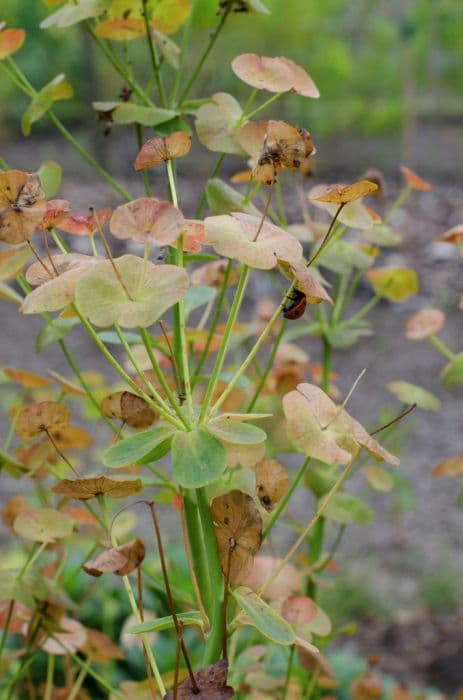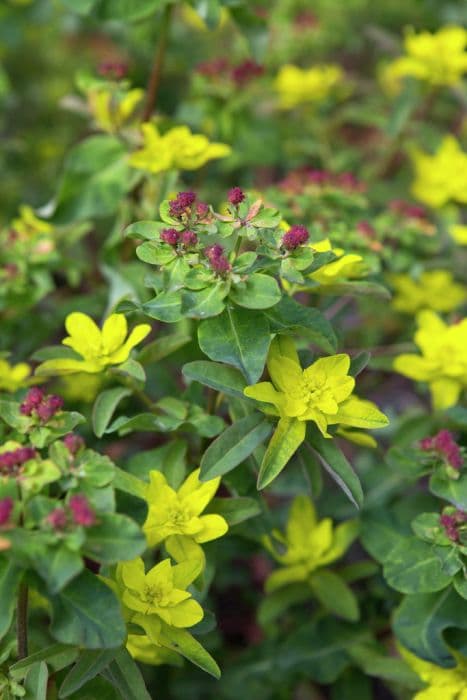Spurge [Diamond Frost] Euphorbia hypericifolia Diamond Frost = 'Inneuphe' (PBR)
![spurge [Diamond Frost]](/_next/image?url=https%3A%2F%2Fplants-admin.emdemapps.com%2Fimages%2Fplants%2F%2Fimages%2F604b5d56905dd.png&w=3840&q=75)
ABOUT
[Diamond Frost] is a tender evergreen perennial, with small, dark green leaves, a tangle of fine, airy stems and tiny white flowers from spring to autumn
About this plant
 Names
NamesFamily
Euphorbiaceae
Synonyms
Diamond Frost Spurge, Diamond Frost Euphorbia
Common names
Euphorbia hypericifolia Diamond Frost 'Inneuphe' (PBR).
 Characteristics
CharacteristicsLife cycle
Annuals
Foliage type
Evergreen
Color of leaves
Green
Flower color
White
Height
1-1.5 feet (30-45 cm)
Spread
1-2 feet (30-60 cm)
Plant type
Herb
Hardiness zones
10
Native area
Central America
Benefits
 General Benefits
General Benefits- Easy to Grow: Requires minimal maintenance and is adaptable to various growing conditions.
- Drought Tolerant: Once established, it can withstand dry periods, reducing the need for frequent watering.
- Continuous Blooming: Produces delicate, airy white flowers that bloom from late spring until frost.
- Attracts Pollinators: Its flowers attract butterflies, which can help pollinate other plants in the garden.
- Versatile Usage: Can be used in containers, hanging baskets, as a bedding plant, or in mixed borders for added texture.
- Heat Resistant: Performs well even in high temperatures, ideal for warm climates.
- Non-Invasive: Unlike some Euphorbia species, it is not known to be invasive, making it a responsible gardening choice.
- Frost Tolerance: Can withstand light frosts, making it suitable for a long growing season.
- Compact Size: With its mounded habit, it fits well in small spaces and does not overpower other plants.
- Pairing Potential: Complements many other plants with its fine foliage and acts as a filler in arrangements.
 Medical Properties
Medical PropertiesThis plant is not used for medical purposes.
 Air-purifying Qualities
Air-purifying QualitiesThis plant is not specifically known for air purifying qualities.
 Other Uses
Other Uses- Photography Backdrop: Euphorbia Diamond Frost can be used as a delicate and attractive backdrop for macro and close-up photography, highlighting details of insects or other small subjects.
- Fairy Gardens: Due to its fine texture and airy appearance, it serves as an ideal plant choice for creating whimsical fairy gardens, enhancing the miniature landscapes.
- Educational Tool: Botany educators can use Euphorbia Diamond Frost to teach students about plant structure, growth patterns, and the diversity of the Euphorbiaceae family.
- Seasonal Arts and Crafts: Its small, white flowers and lush foliage can be dried and used for creating wreaths, holiday decorations, or other arts and crafts projects.
- Textile Dyeing: Although not commonly known for this purpose, some plant materials can be used to dye fabrics; experimenting with Euphorbia Diamond Frost may yield unique shades.
- Plant Combinations: Garden designers can use this plant as a case study to teach about combining plants in garden beds or containers for different visual effects.
- Creative Writing Inspiration: The delicate nature of Euphorbia Diamond Frost could inspire writers and poets as a symbol of purity and innocence in their work.
- Culinary Garnish: While not edible, on special occasions the flowers could be used as a temporary, decorative garnish for plating in high-end culinary presentations, if removed before consumption.
- Frost Mimicry for Displays: During the holiday season, Euphorbia Diamond Frost can be incorporated into wintry scenes in shop displays to represent frost due to its delicate, white blooms.
- Model Landscaping: Enthusiasts creating model train sets or architectural models can use Euphorbia Diamond Frost to mimic shrubbery or overgrown, natural areas on a small scale.
Interesting Facts
 Feng Shui
Feng ShuiThe Diamond Frost euphorbia is not used in Feng Shui practice.
 Zodiac Sign Compitability
Zodiac Sign CompitabilityThe Diamond Frost euphorbia is not used in astrology practice.
 Plant Symbolism
Plant Symbolism- Delicate Beauty: The white, airy flowers of Diamond Frost evoke a sense of delicate beauty, as they appear to float above the foliage.
- Purity and Innocence: Traditionally, white flowers are associated with purity and innocence, which applies to the pristine white blooms of Diamond Frost.
- Resilience and Survival: Euphorbia plants are known for their hardiness and ability to survive in difficult conditions, symbolizing resilience and the ability to endure challenges.
- Contrast and Balance: The fine texture of the Diamond Frost blooms against its dark green foliage can symbolize the importance of contrast and balance in life.
- Transcendence: The "frosty" appearance of the plant's flowers gives the impression of something ethereal and other-worldly, signifying transcendence and the overcoming of worldly matters.
 Water
WaterFor the Diamond Frost Euphorbia, water thoroughly when the top inch of soil feels dry to the touch, which may be approximately once weekly, depending on environmental conditions. It's important to provide enough water to saturate the root zone; for a potted plant, this might be around 16 to 32 ounces, depending on the size of the pot and plant. During active growth periods in spring and summer, watering frequency may increase, while in winter it should decrease. Avoid overwatering—ensure the pot has good drainage to prevent water from pooling around the roots. It’s better to underwater slightly than to overwater this plant, as it is somewhat drought tolerant.
 Light
LightDiamond Frost Euphorbia thrives in bright, indirect sunlight and can tolerate partial shade. It's best to place it in a spot that receives several hours of indirect sunlight a day, such as near a south-facing window with sheer curtains or a north-facing window that gets plenty of ambient light. Direct midday sun might be too intense and can scorch the foliage, so if you only have a sunny spot, diffuse the light with a shade or move the plant slightly out of the direct sun.
 Temperature
TemperatureDiamond Frost Euphorbia prefers temperatures between 60°F and 75°F for ideal growth. It can tolerate minimum temperatures down to around 50°F, but should not be exposed to temperatures below this for extended periods. The plant may also survive short spells in temperatures up to 80°F to 85°F, but prolonged heat can stress the plant. Always protect it from frost and freezing temperatures.
 Pruning
PruningPruning helps maintain the bushy and attractive shape of Diamond Frost Euphorbia and encourages new growth. Light pruning can be done any time of the year to remove dead or yellowing leaves. For a more substantial trim to shape the plant or encourage bushiness, the best time to prune is in late winter or early spring before new growth starts. Pruning is typically needed once per year, but the plant tolerates additional light trimming as needed.
 Cleaning
CleaningAs needed
 Soil
SoilEuphorbia 'Diamond Frost' thrives in a well-draining potting mix with added perlite or sand for aeration. A pH between 6.0 and 7.0 is ideal for this euphorbia variety.
 Repotting
RepottingEuphorbia 'Diamond Frost' should be repotted every 2-3 years or when it outgrows its current container, using fresh soil mix to replenish nutrients.
 Humidity & Misting
Humidity & MistingDiamond Frost Euphorbia prefers moderate humidity levels, but it is quite adaptable and can tolerate lower indoor humidity without issues.
 Suitable locations
Suitable locationsIndoor
Provide bright light, well-draining soil, and infrequent water for indoor Diamond Frost.
Outdoor
For outdoor growth, place in full sun to part shade and well-draining soil.
Hardiness zone
10-11 USDA
 Life cycle
Life cycleEuphorbia hypericifolia 'Diamond Frost', commonly known as Diamond Frost Spurge, begins its life cycle as a seed which germinates in warm, well-drained soil, ideally in full sun or partial shade. Upon sprouting, the seedling develops a root system and foliage, growing into a bushy, herbaceous plant. The vegetative stage is characterized by the growth of its distinctive delicate, grey-green leaves and the plant continues to mature and become bushier. As it enters the flowering stage, Diamond Frost Spurge produces an abundance of tiny white flowers that give it a frothy, cloud-like appearance, blooming continuously from late spring until the first frost. The plant is a perennial in warm climates where it can survive the winter, but is often grown as an annual in colder regions. After flowering, if conditions allow, it can set seed for the next generation, completing its life cycle.
 Propogation
PropogationPropogation time
Spring-Summer
Propogation: The Euphorbia hypericifolia 'Diamond Frost', commonly known as Diamond Frost Euphorbia, is typically propagated by cuttings. The best time to take cuttings is in late spring or early summer when the plant is actively growing. To propagate, a 3 to 4 inch (about 7.5 to 10 cm) stem cutting with several leaves is taken from a healthy parent plant. The cutting should be made just below a leaf node, and the lower leaves should be removed. The cut end can then be dipped into rooting hormone powder to encourage root development and planted in a well-draining soil mix. The cutting should be kept moist but not waterlogged and placed in bright, indirect light. Roots usually develop within a few weeks, and the new plant can gradually be acclimated to normal growing conditions.


![Spurge [Silver Swan]](/_next/image?url=https%3A%2F%2Fplants-admin.emdemapps.com%2Fimages%2Fplants%2F%2Fimages%2F604b573f6c8f6.png&w=640&q=75)






